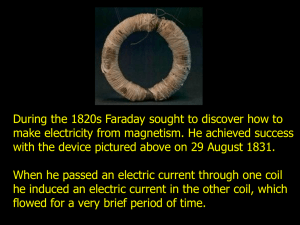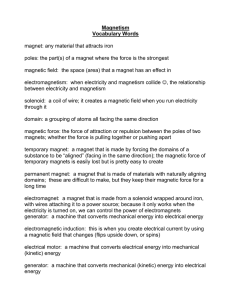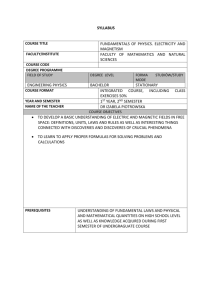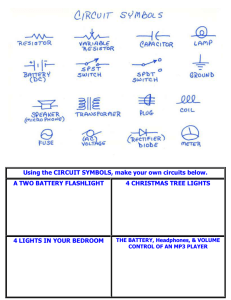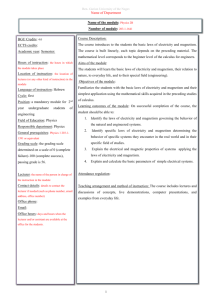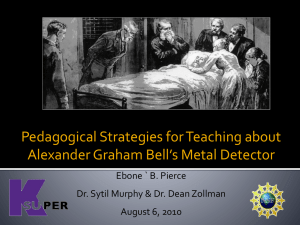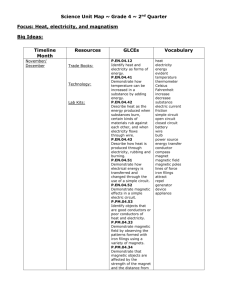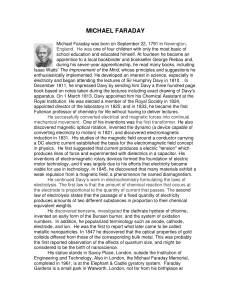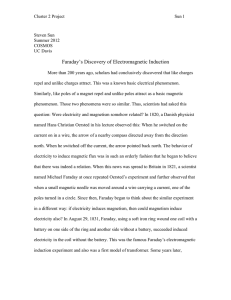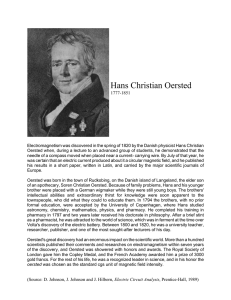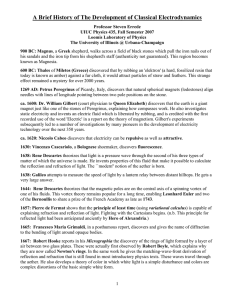Slides: Induction--Maxwell & Faraday (Nov. 5)
advertisement
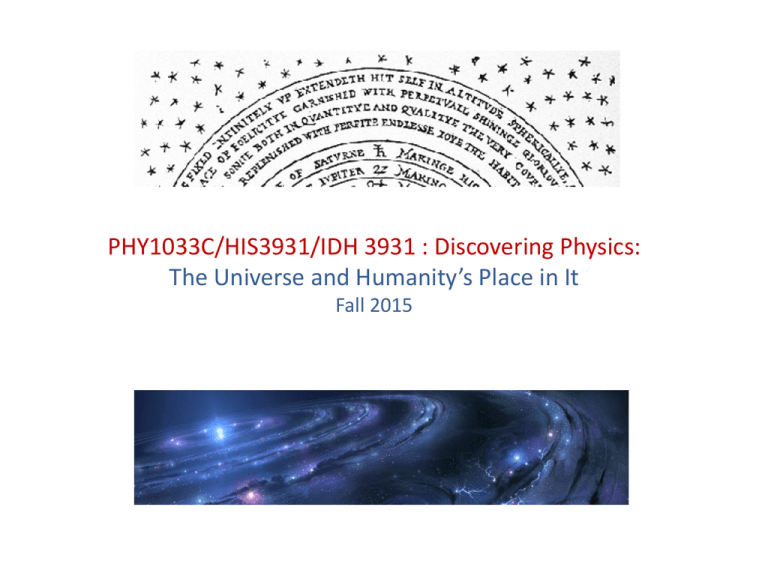
PHY1033C/HIS3931/IDH 3931 : Discovering Physics: The Universe and Humanity’s Place in It Fall 2015 Announcements • HW 7 due today HW8 posted, due Nov. 10 • Reading: Chapter 16, pp. 331-39; Chapter 20, pp. 411-18, 425-29, 431-33 • Thurs., Nov. 12 4pm after class, NPB 2165: Optional film: Relativity pizza party! • HW 6 remark: acceleration due to gravity Last time • Coulomb’s law of electrostatics: F = k q1 q2 / r2 (another inverse square law, but q = charge can be either + or - neutral atoms form, prevent most obvious manifestations of electrostatic forces • History of magnetism: ancient, medieval ideas de Magnete, W. Gilbert 1600 • 1600s, 1700s: suspicion that electricity and magnetism were related (lightning reversed ship’s compass), but unable to prove in laboratory • 1820: H.C. Oersted shows that current in wire deflects compass needle (“circular force”) [Oersted expt with iron filings] Last time • Ampère: - there’s a force between two parallel current-carrying wires [Ampère expt with 2 wires] - a current can magnetize an iron bar - permanent magnets must be made of molecules with tiny circulating currents that line up. • Earth is a permanent magnet due to circulating charged currents in its core Clicker question In 1820 Hans Christian Oersted discovered that A) A current carrying wire orients compass needles along its length B) A loop of current-carrying wire acts as a compass C) Electricity and magnetism come from gravity D) The force on a compass needle acts in circles around a current-carrying wire E) Electricity can be used to make a motor Magnetic fields Michael Faraday (1781-1867) imagined lines of a “force field” that extended into space around a magnet. The “magnetic field” at a point in space provides a force if a magnet or current is placed there Using electricity to produce magnetism Oersted Ampere Faraday asked: Can we use magnetism to produce electricity? Before we get to that Let’s look at some of his other experiments Michael Faraday Faraday’s unusual background made it highly unlikely that he would ever learn science Poor – apprenticed in the bookbinding trade Sandemanian Very little education – no mathematics A couple factors came together to make the unlikely happen Very intelligent mind Very industrious Lucky break Very soon after he learned about Oersted’s experiment he did one of his own He showed how to use electromagnetism to produce mechanical force He invented the electric motor Faraday’s lines of force Ten years later he succeeded in his pursuit Could a magnetic field induce a current in a second wire? 1831 Answer? Yes and no He realized that magnetism generates electricity whenever the magnetic field changes Another way to interrupt a magnetic field would be to insert a magnet into a coil We can show it here Faraday realized that cutting the lines of a field with a magnet generates electricity Faraday confused many natural philosophers because his nonmathematical way of envisioning things was not what they were used to Were there really lines of force out there in nature? How seriously should we take the models we come up with? Couldn’t deny Faraday’s successful discoveries The question about the status of models soon came up again How are we to understand the close link between electricity and magnetism Faraday had assumed that induced current was transmitted as a wave But a wave of what? What was it that was waving? James Maxwell in Scotland in 1865 assumed the answer was: the ether, which was Everywhere Magnetic effects Electric effects The model shows why changing electricity produces magnetism and vice versa Maxwell’s Equations These equations are wave equations: Electromagnetism is transmitted as waves in the ether in a wire And they reveal an incredible new discovery From quantities present in his equations Maxwell was able to calculate the speed with which electromagnetism moves Turned out to be c, the speed of light! Light was known to be a wave (Young experiment 1801) “We can scarcely avoid the inference that light consists of the transverse undulations of the same medium which is the cause of magnetic and electric phenomena” -- Maxwell What goes into Maxwell’s speed of light calculation c = 1/√ε0μ0 “dielectric constant of free space” Related to Coulomb’s constant k -- measurable in laboratory “permeability of free space” Related to magnetic fields produced by electrical currents -- measurable in the laboratory Maxwell substituted these known values and came up with c=3 108 m/s, speed already known from Roemer measurements (1676). Fiat lux! Since the ether is everywhere, it is also in space Light is transmitted through space Theoretically electromagnetism could be transmitted through space as well as through wires Maxwell and others did not attempt to confirm electromagnetic waves in space Other developments in physics suggested that models were descriptions of nature “as it really is” Kinetic theory of gases Whole age had become confident it was nailing down the truth of nature The region of objective knowledge belonged to science alone. We are closing in on the final truth of nature We are describing nature “as it really is.” John Tyndall Second half of the 19th century has been called the “Age of Realism” Classical physics a good expression of the age Other developments in science reinforce this attitude Another side of an attitude is an impatience with idealism Bismarck’s Realpolitik Realism in art Realism in literature As you might guess, the overconfidence that comes with thinking one knows what’s really the case can be naive We’ll see it begin to unravel in physics next week

